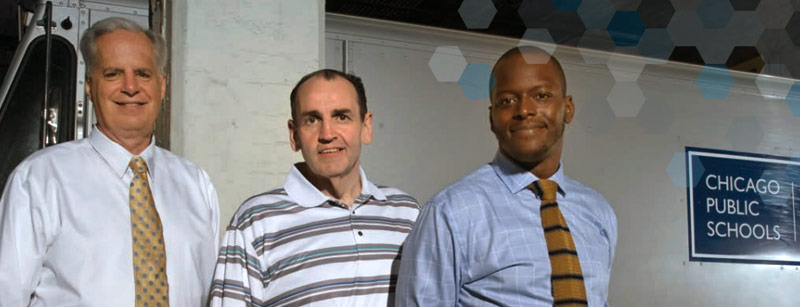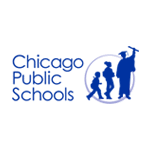Chicago Public Schools
Customer Spotlight
Zonar Helps Chicago Public Schools Erase $20 Million in Student Transportation Expenses.
While it didn’t surprise him, Paul Osland still couldn’t believe it when he saw the line through all of the checklist items on the bus inspection sheet.
After all, it was a Saturday morning in 2012 and the Chicago Public Schools new student transportation services director was looking at a driver pre-trip inspection form for a school bus before its trip that Monday morning. And yet it was all filled out with all of the inspection items already checked.
“It’s what’s known as pencil whipping it,” Osland recalled. “While it’s not an uncommon practice among drivers, it’s not something bus companies encourage.”
After all, pencil-whipping is one way drivers cut corners so they don’t have to arrive as early to do their pre- and post-trip inspections, Osland explained. They can just jump in the buses and get going in the morning. How hard vendors work at discouraging the practice among drivers can vary.
In late July, Osland was promoted to chief of facilities at the Chicago Public Schools due in part to the success he achieved as the student transportation services department director for the last three years. Shortly after he started his job as transportation director for the district in May of 2012, Osland saw the form during an unannounced Saturday morning inspection. And he knew the Chicago Public School District needed a way to hold school bus vendors and their drivers more accountable.
Just a year earlier, one of the district’s vendors had settled a $1 million lawsuit filed by a family whose child had fallen asleep and was not seen by an inattentive school bus driver when he parked the bus parked overnight in the vendor’s parking lot.
Chicago Public Schools Increases Number of Runs Per Bus by 18.5 Percent.
As part of a transportation accountability and transparency initiative Osland started, the department and the district’s 20 bus transportation vendors installed Zonar telematics system on all of the district’s buses and integrated it into the student transportation services bus routing and scheduling software. In addition to preventing the pencil-whipping practice, this initiative succeeded in significantly reducing the bill for student transportation for Chicago taxpayers by a total of $20 million.
The department operated on a $114.7 million budget for the 2014-15 school year, which ended in June. That translates into savings of $15 million over the $130 million student transportation budget for the 2012-13 school year when the department had a fleet of 1,600 buses and vans operated by 22 vendors.
The savings resulted from optimizing routes and reducing the size of the district’s bus fleet by 350 buses. With a more than 20 percent reduction in fleet size, the district also realized some transportation aide staffing efficiencies, resulting in an additional $5 million savings for another department in the district.
Zonar’s telematics equipment, specifically the Zonar Electronic Verified Inspection Reporting (EVIR®) system, greatly contributed to the success of the transportation initiative, which also reduced the problem of children being left on the bus. In fact, the district’s 20 vendors went almost an entire year without a single incident.
The initiative also resulted in an increase of runs per bus from 2.7 to 3.2 – an efficiency improvement of 18.5 percent for each bus in the district’s 1,235 school bus fleet. As a result of the operational improvements made possible through Zonar’s telematics system, Osland said each school bus is now completing, on average, an additional ½ of a run each day.
Zonar’s solution allows Osland to see where and when buses are being underutilized – when they were getting to the next pickup locations or schools early. And by rearranging schedules and reassigning buses to do more runs or pick up more children, he reduced the size of the district’s fleet. Osland also reassigned school bus aides, so they covered more than one school.
Chicago Public Schools works toward goal of no child left behind on a bus.
Shortly before his promotion in July, Osland joined representatives from Zonar to present the results of the transportation initiative at the Council of Great City Schools Chief Operating Officers Conference in Las Vegas. While Osland takes pride in the operational savings the district achieved, it’s the near-elimination of a problem with students being left on buses that he appreciates most.
In 2012, the district’s buses completed 750,000 runs and students were left on buses at a rate of 1 in 80,000 runs. That means nearly a dozen students were still aboard buses after they dropped off children and pulled away from the school in 2012. After full implementation of the district’s transportation initiative, Osland said only one incident occurred in February of 2015 – making for a rate of 1 in a million runs, in the 2015 school year.
Zonar’s 2010 helped the district realize significant operational efficiencies by prompting drivers to conduct their required pre- and post-trip vehicle inspections. By prompting drivers to conduct their seat checks before they go to the next school or end their shifts, the district also nearly eliminated the left-behind problem.
“Having a student left on a bus, even if the bus were to go no further than a block from the school when the student’s found aboard, is something the district simply must avoid,” Osland said. “When a child gets left on a bus, it can have the potential to get very ugly. Parents, in this day and age, imagine the worst and then the lawsuits start flying.”
Most of the 400,000 students who attend the 800 schools in the Chicago Public Schools district walk, ride bicycles or take public transportation to their neighborhood schools. But about 22,500 at-risk, special needs and gifted children are transported on a fleet of 1,235 buses and 115 vans, operated by contracted vendors.
Osland said they had a largely underutilized telematics system installed on its buses before adopting Zonar. That system also didn’t provide the capabilities the district needed to ensure that bus drivers completed their vehicle inspections and end-of-run seat checks to be sure their buses were empty. So, the district sent out a request for proposals.
“Throughout the entire process, we were looking for a telematics solution that could help us focus on three key things – safety, efficiency and service,” Osland recalled. “These were the three key areas we wanted folks in the student transportation services department to concentrate on.”
Through the process, the district identified Zonar telematics as its best choice. Zonar’s 2010 handheld provided the key functions the district needed to realize significant efficiencies through route optimization, Osland said. It also helped the department to integrate student checks effectively into the drivers’ routines, he said.
Using the 2010, drivers can sign in at the start of their shift by first scanning an RFID card that identifies the driver, and then an RFID asset tag that identifies the bus. The drivers manually input their routes and then conduct their pre- trip inspections using the hand-held device’s radio frequency identification (RFID) tag reader and interactive menu.
Zonar helps end the “now you see me, now you don’t” problem with substitutes.
Because drivers can match buses to routes when they start their day using the 2010 handheld, Osland said that eliminates a problem that still plagues many school transportation directors – the ability to track substitute buses.
“A school bus transportation fleet is going to have at least 10 percent, maybe even as high as 20 percent of its fleet reassigned to different routes on any given day,” Osland said. “This could be due to maintenance or equipment issues or a variety of other reasons.”
Since the driver can match the bus with a route at the start of the day, Osland said the department now has visibility with buses that would have been nearly invisible otherwise.
“At any given moment, the department has visibility somewhere well north of the 90 percentile of all the units in the district’s school bus fleet,” Osland said. “That’s a huge relief.”
At the end of each run, after completing their seat checks, the drivers use the handheld device to scan an RFID tag located at the back of the bus. The handheld interactive menu then queries the drivers whether they have completed the seat checks.
The device transmits the drivers’ responses to Zonar’s servers in real-time along with timestamps of when they started their seat checks and vehicle inspections and how long it took drivers to complete them. Zonar’s servers then interface with the department’s EDULOG school bus routing and scheduling software and GPS tracking software, providing what Osland calls “actionable information.”
Zonar allows transportation chief to grade school bus vendors
“Zonar’s telematics system and 2010 provides the department and its vendors a way to hold drivers more accountable,” he said. “Now instead of getting driver inspection forms with no indication of when they did them or how long they took, department managers can see all of those details, plus when the buses left and when they arrived, in their department’s EDULOG software.”
Osland said other telematics providers don’t offer the same interactive capability with EDULOG.
“Instead, you need to extract information from EDULOG and then manually import it into the telematics system in order to analyze the data,” he added.
“When Zonar interfaces with EDULOG, you can avoid that,” Osland said. “And that’s important, because when the district can pull up actual arrival times (populated) on EDULOG (by Zonar), it can then compare what’s planned with what’s actually happened.”
“I call that actionable information,” he said. “If the department’s management sees buses arriving late at the first school, then they know they likely have problems with drivers getting to work on time. But if they see buses on time for their first runs, but late for their second ones, then they know they’ve got routing issues.”
Access to the telematics data on the EDULOG software means department managers can also keep tabs on vendors’ on-time performance, which is now well above 90 percent. That’s a significant improvement over the vendor’s 70 to 80 percent average on-time performance in 2012. “Getting children to school on time, especially in Chicago during rush hour can be challenging to say the least,” Osland said. “Having good and timely reporting every day is critical to ensuring a high level of service.”
Osland said the department also uses the telematics data to produce quarterly reports, which managers can go over with each vendor.
“These quarterly reports take all of the emotion out of the equation,” Osland said. “There’s no more excuses – ‘well, how do you know my driver did that?’ Or ‘how do you know my driver didn’t pick up those kids. That’s just some disgruntled parent.’ There’s no more ‘he said, she said.’ Now the department has irrefutable data, which shows vendors how they compare to their peers using the same metrics. I think that’s the real value of this.
“When I was student transportation services director, I had a number of vendors tell me that even though it took a while for them to adjust to the greater scrutiny, they understood its necessity,” he said. “They told me that these higher expectations made them a better company. And while not all vendors meet every one, certainly all of them truly care about the children they carry and the services they provide. They don’t want to see children left on their buses. And they want their drivers to check consistently. Zonar provides them the necessary tools to achieve consistency and meet a variety of other great expectations.”






